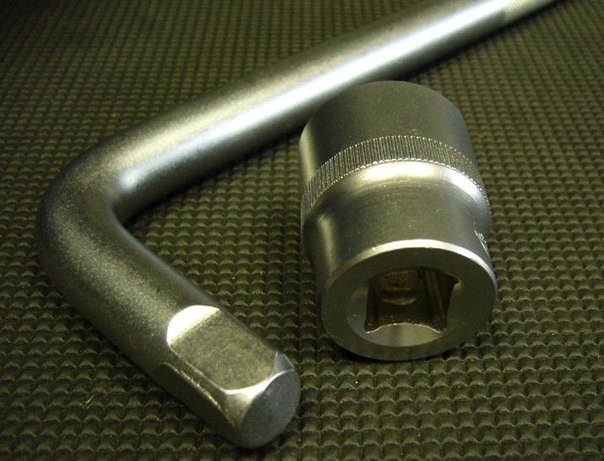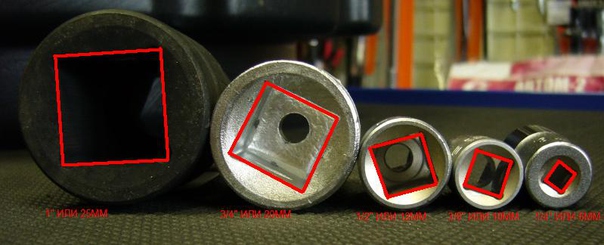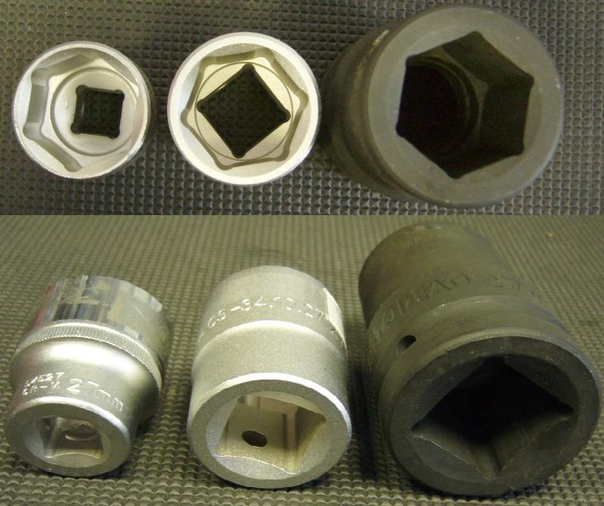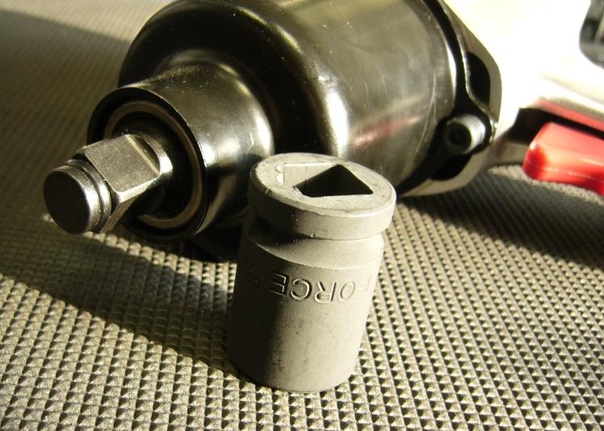This need is due to the fact that we often spend a lot of time to correctly understand what our customers need. And we will start with the socket heads.
End heads in their designation have two dimension parameters: the size of the head itself and its "landing" or "connecting" square. In addition, sockets have three "design" parameters: head profile, head depth, and head alloy type.
To accurately designate the end head, you must specify: type of steel; length (height); profile; Name; working size; connecting square size; brand (manufacturer). Example: 17mm 1/2” King Tony deep hex socket.
Let's start with the size of the head, which can be specified depending on the country with which measurement system it is made: in millimeters (mm) - the metric system or in inches (inch) - the inch system of measurement.
For the metric system, the dimensions of King Tony socket heads imported into Russia are as follows in millimeters:
4, 4.5, 5, 5.5, 6, 7, 8, 9. 10, 11, 12, 13, 14, 15, 16, 17, 18, 19, 20, 21, 22, 23, 24, 25, 26, 27, 28, 29, 30, 31, 32, 33, 34, 36, 38, 39, 41, 46, 48, 50, 51, 52, 53, 54, 55, 56, 57, 58, 59, 60, 63, 65, 70, 71, 75, 77, 80 mm.
For the inch system, the dimension of the King Tony socket heads imported into Russia is the following series in inches:
5/32, 3/16, 7/32, 1/4, 9/32, 5/16, 11/32, 3/8, 7/16, 15/32, 1/2, 9/16, 19/ 32, 5/8, 11/16, 3/4, 13/16, 7/8, 15/16, 1, 1-1/16, 1-1/8, 1-3/16, 1-1/ 4, 1-5/16, 1-3/8, 1-7/16, 1-1/2, 1-9/16, 1-5/8, 1-11/16, 1-3/4, 1-13/16, 1-7/8, 1-15/16, 2, 2-1/16, 2-1/8, 2-3/16. 2-1/4, 2-5/16, 2-3/8, 2-7/16, 2-1/2, 2-9/16, 2-5/8, 2-11/16, 2- 15/16, 3-1/8 in.
One inch in terms of the metric system is equal to 25.4 mm. Thus, although inch and metric heads are close in size, their dimensions do not completely coincide. That's why our metric sockets are not suitable for servicing cars or equipment made for countries with an inch system of measurement.
The second dimension parameter - "connecting" or "landing" square - is the size of the square hole on the back side of the end head. It depends on him which collars, extensions or ratchets you can attach to the socket head. There are five main sizes of the connecting hole, called "square" for short, and they are all indicated in inches. Thus, regardless of what kind of socket you have - metric or inch - the connecting square for it can have the following dimensions in inches:
1/4, 3/8, 1/2, 3/4, 1 in.
Wherein:
1/4 inch = 6.35mm
. 3/8 inch = 9.53mm
. 1/2 inch = 12.7mm
. 3/4 inch = 19.05mm
. 1 inch = 25.4mm
Heads with different connecting squares have different design. The larger the connecting square, the thicker the walls of the end head and, accordingly, the greater the load that it can withstand. A 13 mm socket with a 1/4" square connection and a 13 mm socket with a 1/2" square are completely different in their strength and product design.
The dimensions of the heads are also tied to the connecting square. For example, 1/4" square sockets are only available up to 14mm, 1/2" square sockets up to 32mm (special series up to 36mm). This is due to the fact that the larger the dimension of the end head, the greater the effort it must cope with, but there is a design limit after which it is impossible to provide sufficient head strength without thickening its walls and switching to a larger connecting square.
The dimensions of King Tony metric socket heads, depending on the connecting square, look like this:
1/4 inch - 4 to 14 mm
. 3/8" - 6 to 24 mm
. 1/2 inch - 8 to 36 mm
. 3/4" - 17 to 70 mm
. 1 inch - 36 to 80 mm
Now about the profiles of the socket heads. There are quite a lot of them, but now we will talk about only two “standard” ones. These are socket heads with a hexagonal profile and socket heads with a twelve-sided profile. We see the profiles themselves in the pictures, but what is their difference and which one is better? There is no single answer to this question. Each of the profiles in a certain situation has its own advantages.
 The hexagonal profile of the socket completely repeats the profile of the nut or bolt. Therefore, heads with a hexagonal profile work with fasteners more carefully than dodecahedral ones, the risk of "licking" the edges of nuts or bolts from their use is minimal.
The hexagonal profile of the socket completely repeats the profile of the nut or bolt. Therefore, heads with a hexagonal profile work with fasteners more carefully than dodecahedral ones, the risk of "licking" the edges of nuts or bolts from their use is minimal.
 But when work is carried out in a limited space, when it is very difficult to get close to a nut or bolt, then the advantage of a twelve-sided profile comes to the fore. Heads with a twelve-sided profile have a greater number of angles under which they are put on fasteners. Therefore, in conditions where the space around the fastener is limited, it is more convenient to work with twelve-sided socket heads.
But when work is carried out in a limited space, when it is very difficult to get close to a nut or bolt, then the advantage of a twelve-sided profile comes to the fore. Heads with a twelve-sided profile have a greater number of angles under which they are put on fasteners. Therefore, in conditions where the space around the fastener is limited, it is more convenient to work with twelve-sided socket heads.
TO design features end heads also includes the depth of their working surface, depending on which heads are usually called "short" or "deep". For each standard size of the connecting square of the socket heads, this value is different. For "short" sockets, King Tony's factory adopted the following face depths:
1/4 inch - 4 to 9 mm
. 3/8" - 7 to 17 mm
. 1/2 inch - 7 to 24 mm
. 3/4" - 14 to 34 mm
. 1 inch - 26 to 52 mm
For "deep" sockets of the King Tony brand, the following depths of the working surface are established:
1/4 inch - 6 to 21 mm
. 3/8" - 10 to 25 mm
. 1/2 inch - 15 to 36 mm
. 3/4" - 20 to 53 mm
. 1 inch - 21 to 80 mm
Finally, sockets are differentiated by the alloy they are made of and are divided into "standard" and "impact" sockets. In the production of standard socket heads, King Tony uses chrome-vanadium tool steel, these sockets are much more ductile than impact sockets. In the production of impact sockets of the King Tony brand, tool chrome-molybdenum steel is used. Unlike standard sockets, impact sockets are black in color, they are more resistant to impact, but less plastic.
Thus, in order to accurately designate the socket head, you must specify:
steel type;
. length (height);
. profile;
. Name;
. working size;
. connecting square size;
. brand (manufacturer).
impact deep hex socket 17 mm 1/2” King Tony
Only in this case there will be no additional questions.
Socket heads: what is important to know?
Socket heads, they are socket wrenches, they are socket wrenches. All heads can be conditionally divided into 2 large groups.
The first group - heads with through hole(under collar). The size range starts from 17mm.
The main advantage of these heads for the crank is to work with them not needed special collar, which is for heads big size costs much more than the head itself. You can use a mount or any other wrench of a suitable diameter. Among the shortcomings, we note the inability to work in a limited space and with recessed fasteners. You won't be able to use an extension cord.
The second group - heads with a connecting square under the collar. The size range starts from 4mm. 
It is worth talking about this group in more detail. For convenience, we will divide the group according to certain parameters.
The first parameter is the size of the connecting square.
The connecting square or landing square is a square hole on the back of the head. The size of a square is measured in units that are unusual for us - inches. Inch from the Dutch duim - thumb). An inch is indicated by a double stroke ” and is equal to 25.4mm.
Interestingly, the OIML (International Organization of Legal Metrology) believes that the inch is a unit of measurement that should be phased out as soon as possible and should not be introduced where it is not currently used. In the Russian Federation, an inch is approved for use as an off-system unit without a time limit with the scope of "industry".
The photo below shows the 5 most popular sizes of connecting (landing) squares.
1", 3/4", 1/2", 3/8", 1/4".

Frequently Asked Question: How much is this in millimeters?
Answer:
- 1 inch = 25.4mm,
- 3/4 inch = 19.05mm,
- 1/2 inch = 12.7mm,
- 3/8 inch = 9.53mm,
- 1/4 inch = 6.35 mm.

The larger the connecting square, the more powerful the head. The wall is thicker, the maximum load is higher. The next photo shows heads with a working size of 27mm, but with different connecting squares: 1/2", 3/4", 1".
The difference in wall thickness is clearly visible and, as a result, the margin of safety when moving to a larger connecting square. The size range of heads is also attached to the size of the connecting square.
- Square 1/4" - sockets from 4mm to 14mm.
- Square 3/8" - sockets from 6mm to 24mm.
- Square 1/2" - sockets from 8mm to 36mm.
- Square 3/4" - sockets from 17mm to 70mm.
- Square 1" - sockets from 36mm to 80mm.
The second parameter is applicability.
1. IMPACT heads for working with pneumatic and power tools. Heads are designed for impact loads. Manufactured from high quality steel with added molybdenum (Mo) for toughness. Usually oxidized, black.

They have, unlike standard heads, a thicker wall, although there are also thin-walled impact heads, for example, for working with cast disks.
12.11.2014
Today we will talk about the standards adopted to designate such a widely used repair tool as a socket head.
This need is due to the fact that we often spend a lot of time to correctly understand what our customers need. And we will start with the socket heads.
End heads in their designation have two dimension parameters: the size of the head itself and its "landing" or "connecting" square. In addition, sockets have three "design" parameters: head profile, head depth, and head alloy type.
To accurately designate the end head, you must specify: type of steel; length (height); profile; Name; working size; connecting square size; brand (manufacturer). Example: 17mm 1/2” Force Impact Deep Hex Socket.
Let's start with the size of the head, which can be specified depending on the country with which measurement system it is made: in millimeters (mm) - the metric system or in inches (inch) - the inch system of measurement.
For the metric system, the dimension of the sockets of the manufacturer Force, is the following series in millimeters:
4, 4.5, 5, 5.5, 6, 7, 8, 9. 10, 11, 12, 13, 14, 15, 16, 17, 18, 19, 20, 21, 22, 23, 24, 25, 26, 27, 28, 29, 30, 31, 32, 33, 34, 36, 38, 39, 41, 46, 48, 50, 51, 52, 53, 54, 55, 56, 57, 58, 59, 60, 63, 65, 70, 71, 75, 77, 80 mm.
For the inch system, the dimension of the sockets of the manufacturer Force, is the following series in inches:
5/32, 3/16, 7/32, 1/4, 9/32, 5/16, 11/32, 3/8, 7/16, 15/32, 1/2, 9/16, 19/ 32, 5/8, 11/16, 3/4, 13/16, 7/8, 15/16, 1, 1-1/16, 1-1/8, 1-3/16, 1-1/ 4, 1-5/16, 1-3/8, 1-7/16, 1-1/2, 1-9/16, 1-5/8, 1-11/16, 1-3/4, 1-13/16, 1-7/8, 1-15/16, 2, 2-1/16, 2-1/8, 2-3/16. 2-1/4, 2-5/16, 2-3/8, 2-7/16, 2-1/2, 2-9/16, 2-5/8, 2-11/16, 2- 15/16, 3-1/8 in.
One inch in terms of the metric system is equal to 25.4 mm. Thus, although inch and metric heads are close in size, their dimensions do not completely coincide. That's why our metric sockets are not suitable for servicing cars or equipment made for countries with an inch system of measurement.
The second dimension parameter - "connecting" or "landing" square - is the size of the square hole on the back side of the end head. It depends on him which collars, extensions or ratchets you can attach to the socket head. There are five main sizes of the connecting hole, called "square" for short, and they are all indicated in inches. Thus, regardless of what kind of socket you have - metric or inch - the connecting square for it can have the following dimensions in inches:
1/4, 3/8, 1/2, 3/4, 1 in.
Wherein:
1/4 inch = 6.35mm
3/8 inch = 9.53mm
1/2 inch = 12.7mm
3/4 inch = 19.05mm
1 inch = 25.4mm
Heads with different connecting squares have a different design. The larger the connecting square, the thicker the walls of the end head and, accordingly, the greater the load that it can withstand. A 13 mm socket with a 1/4" square connection and a 13 mm socket with a 1/2" square are completely different in their strength and product design.
The dimensions of the heads are also tied to the connecting square. For example, 1/4" square sockets are only available up to 14mm, 1/2" square sockets up to 32mm (special series up to 36mm). This is due to the fact that the larger the dimension of the end head, the greater the effort it must cope with, but there is a design limit after which it is impossible to provide sufficient head strength without thickening its walls and switching to a larger connecting square.
The dimension of metric socket heads Force, depending on the connecting square, looks like this:
1/4 inch - 4 to 14 mm
3/8 inch - 6 to 24 mm
1/2 inch - 8 to 36 mm
3/4 inch - 17 to 70 mm
1 inch - 36 to 80 mm
Now about the profiles of the socket heads. There are quite a lot of them, but now we will talk about only two “standard” ones. These are socket heads with a hexagonal profile and socket heads with a twelve-sided profile. We see the profiles themselves in the pictures, but what is their difference and which one is better? There is no single answer to this question. Each of the profiles in a certain situation has its own advantages.
Hex profile end head completely repeats the profile of a nut or bolt. Therefore, heads with a hexagonal profile work with fasteners more carefully than dodecahedral ones, the risk of "licking" the edges of nuts or bolts from their use is minimal.
But when work is carried out in a confined space, when it is very difficult to get close to a nut or bolt, then the advantage comes to the fore dodecahedral profile. Heads with a twelve-sided profile have a greater number of angles under which they are put on fasteners. Therefore, in conditions where the space around the fastener is limited, it is more convenient to work with twelve-sided socket heads.
The design features of the socket heads also include the depth of their working surface, depending on which the heads are usually called "short" or "deep". For each standard size of the connecting square of the socket heads, this value is different. For "short" sockets, the Force factory adopted the following values for the depth of the working surface:
1/4 inch - 4 to 9 mm
3/8 inch - 7 to 17 mm
1/2 inch - 7 to 24 mm
3/4 inch - 14 to 34 mm
1 inch - 26 to 52 mm
For "deep" face heads of the Force brand, the following depths of the working surface are set:
1/4 inch - 6 to 21 mm
3/8 inch - 10 to 25 mm
1/2 inch - 15 to 36 mm
3/4 inch - 20 to 53 mm
1 inch - 21 to 80 mm
Finally, socket heads differ in the alloy from which they are made, and are divided into "standard" and "drums" end heads. In the production of standard socket heads, Force uses chrome-vanadium tool steel, these sockets are much more ductile than impact sockets. In the production of impact sockets of the Force brand, tool chrome-molybdenum steel is used. Unlike standard sockets, impact sockets are black in color, they are more resistant to impact, but less plastic.
Thus, in order to accurately designate the socket head, you must specify:
steel type;
length (height);
profile;
Name;
working size;
connecting square size;
brand (manufacturer).











How to understand: will the kitten be fluffy?
What kind of light alcohol can be drunk for pregnant women: the consequences of drinking
Why do the legs swell in the ankles and ankles of the feet in pregnant women: causes and methods of treatment
The wedding of Prince Harry and Meghan Markle: scandalous and secret details of the marriage (photo) The future marriage of Prince Harry year NTV
How to close white plums for the winter